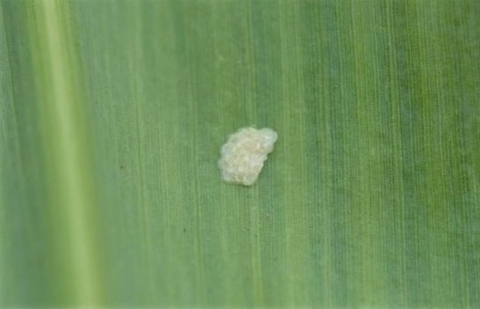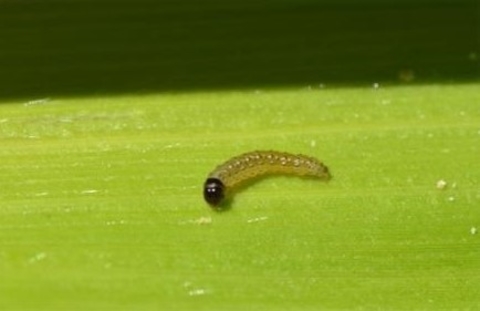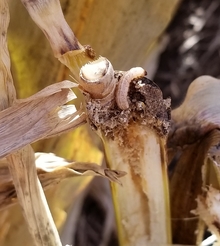A historical perspective
The European corn borer (ECB) was most likely introduced into the US in the early 1900s and into Minnesota in the 1940s. For many years thereafter, ECB was one of the most damaging insects of corn. Prior to the widespread adoption of effective Bt, Minnesota ECB populations went through cyclical fluctuations caused by disease. Since the widespread adoption of Bt, populations have been largely suppressed on an areawide basis.
While current ECB populations are very low overall, areas of Minnesota where a smaller proportion of fields were historically planted to Bt have seen economic threshold populations of this insect. To determine if an application of a foliar insecticide for ECB would provide an economic benefit, scouting of corn without above-ground Bt traits is recommended (See the Handy Bt-trait table for traits effective against ECB).
Biology
Scouting and management is complicated by two biotypes of corn borer. They respond the same to current Bt hybrids (99.5% control) but because of the timing of egg laying with respect to corn development, they do not respond equally well to insecticide applications.
The univoltine biotype has a fixed diapause and only one generation occurs. The multivoltine biotype has multiple generations, typically two in Minnesota, and diapause is determined in the second instar larvae. In warm years, a third generation may be triggered, but these larvae may not reach the 5th larval stage (instar) and be able to overwinter.
The univoltine biotype can overlap a 2nd generation of the multivoltine biotype where they co-exist; creating the potential for egg laying over an extended period and making the timing of insecticide applications difficult. Historically, the univoltine biotype is predominant in the north and the multivoltine in the south.
Overwintering
The larvae of the both biotypes overwinter in corn stalk residues, but they break diapause at different times. In the spring, multivoltine larvae pupate earlier (< 350 degree days (DDs)) than univoltine larvae (> 350 + DDs). This leads to differences in time of year and corn growth stage when moths are active.
Moth emergence and egg laying
After the moths emerge (Figure 1), they congregate and mate in areas of dense vegetation called “aggregation sites” or “action sites”. You may encounter 1st generation univoltine moths in dense grass action sites near corn. The second generation and univoltine will use both dense grasses and soybeans for action sites.
ECB prefer particular corn stages for egg laying. Small corn contains a high concentration of a chemical compound (DIMBOA) that is toxic to ECB larvae and their survival is very low on corn less than 17-inches tall (extended leaf).
First generation females seek out taller, early planted whorl stage corn and lay eggs (Figure 2) near the midrib of a whorl leaf. Corn nearest tassel is most attractive to univoltine moths and 2nd generation moths are attracted to late planted or less mature fields.
Larvae hatch
Larvae hatch in 3-7 days or approximately two weeks after moths emerge. Newly hatched larvae (Figure 3) feed on corn leaf surfaces or pollen if available. The feeding of second instar larvae feeding creates small, round “shotholes” (Figure 4) in whorl stage corn. Ten-day to two-week old 3rd instar larvae can tunnel into leaf mid ribs and stalks. Young univoltine and 2nd generation larvae often feed on pollen and begin tunnels in leaf axils.
ECB damage in corn
Feeding by ECB larvae causes direct, physiological yield losses when stalk tunnels (Fig. 5) disrupt the movement of water, nutrients and photosynthates within the plant. This is the primary way ECB larvae cause corn yield loss. The impact of larval feeding varies with the stage of corn development when the feeding occurs. Losses can range from over 6% loss/borer/plant in pre-tassel corn to 3% loss/borer/plant after pollination.
Corn borer feeding can produce indirect losses by providing entry points for ear and stalk pathogens. The tunnels in stalks and ear shanks create harvest losses due to stalk lodging and ear drop.
Scouting
Corn without Bt protection from ECB requires an investment in scouting. Focus on fields whose development stage would be most attractive to the egg laying moths.
The portion of the corn plant scouted for ECB varies between whorl stage and post- tassel corn. Prior to tassel emergence, scouting should focus on larval feeding (shotholing) and larvae in the whorl. Stop at five spots in the field, pull 10-20 whorls, examine them for feeding, and count any live larvae found when unrolling the whorl. These observations will be used when determining if the field is above an economic threshold. Use the Dynamic ECB Economic Threshold Calculator for whorl stage and post-tasseling corn. To see an example for whorl stage corn, see Table 1.
After tassel emergence, look for egg masses on the underside of the ear leaf and the three leaves above and below the ear. Stop at five spots through the field and examine five plants. These observations can be used to calculate potential losses. Table 2 shows an example of the economic threshold calculations for post-tasseling corn.
Being in the field at the right time is important because larvae are only outside the stalk and exposed to insecticide until the 3rd instar, a 10–14 day period for each generation. Insecticide control must be applied before most larvae reach 3rd stage. Some 3rd instar larvae may leave the mid-rib or stalk before starting new tunnels and be vulnerable but only for a short time. Control declines as after whorl stage corn (80% control). Later ECB generations infest lower in the canopy and are partially protected from insecticide applications (50-70% 2nd generation).
For 1st generation ECB, you will likely need to visit a field weekly for several weeks to make an insecticide treatment decision. Where there are overlapping or multiple generations, the scouting window from pre- through post-tassel corn can be quite broad. The use of ECB light trap captures and degree-day models can help time scouting.
The scouting guide (Table 3) summarizes when and where to scout for the two ECB biotypes in Minnesota.
Economic thresholds
Thresholds for European corn borer can take into account the number of larvae or egg masses/plant, egg or larval survival, estimated yield loss/borer, expected corn yield and price and insecticide and application costs (Table 2, Table 3). Both of these thresholds can be easily set up in a computer or web-based spreadsheet to calculate threshold values.
| 1 | 45 | number of larvae | ÷ | 100 | Number of whorls examined | = | 0.45 | larvae /plant1 |
| 1b | 0.45 | larvae/plant | * | 1.00 | expected % surviving2 | = | 0.45 | larvae/plant |
| 2 | 0.45 | larvae/plant | * | 0.06 | percent loss/larva3 | = | 0.027 | percent yield loss |
| 3 | 0.03 | percent yield loss | * | 200 | expected yield (bushels/acre) | = | 5.40 | bushels loss/acre |
| 4 | 5.40 | bushels loss/acre | * | $3.40 | expected price/bushel | = | $18.36 | expected $ loss/acre |
| 5 | $18.36 | expected $ loss/acre | * | 0.80 | percent control | = | $14.69 | preventable loss/acre |
| 6 | $14.69 | preventable loss | - | $12.00 | cost of control | = | $2.69 | (profit/loss) / acre |
In five parts of the field, pull 20 whorls for shotholing; carefully unroll and examine for live larvae.
Use decimals to represent percentages. For example, 1.0=100%, 0.50=50%, 0.03=3%
1An alternative method is to multiply %whorls with live larvae by average number of live larvae per infested whorl.
2All larvae in whorl will not survive (often less than 50%). You may choose to multiply b a percentage to account for this.
3Use 6% early whorl, 5% late whorl, 6.5% pretassel.
| 1 | 20 | egg masses found* | ÷ | 0.91 | correction1 factor | = | 21.98 | adjusted1 egg masses |
| 2 | 21.98 | adjusted egg masses | ÷ | 50 | plants examined | = | 0.44 | egg masses/plant |
| 3 | 0.44 | egg masses / plant | * | 3.0 | larvae/egg mass2 | = | 1.32 | larvae/plant |
| 4 | 1.32 | larvae/plant | * | 0.03 | percent loss/larva3 | = | 0.040 | percent loss |
| 5 | 0.04 | percent loss | * | 200 | expected yield (bushels/acre) | = | 7.91 | bushels loss/acre |
| 6 | 7.91 | bushels loss / acre | * | $3.40 | expected price/bushel | = | $26.90 | expected $ loss/acre |
| 7 | $26.90 | expected $ loss / acre | * | 0.60 | percent control4 | = | $16.14 | preventable loss / acre |
| 8 | $16.14 | preventable loss | - | $15.00 | cost of control / acre | = | $1.14 | (profit /loss) / acre |
In five parts of the field, carefully examine plants for egg masses on the ear leaf and 3 lvs. above and below.
*Can total counts from previous visit to field.
Use decimals to represent percentages, for example 1.0 = 100% , 0.50 = 50%, 0.03 = 3%.
1Correction factor to account for egg masses on parts of plant other than 7 leaves examined.
2Assumption of 3 larvae from each egg mass survive. Can be none or as high as 4.5. See ISU for estimation based on days after start of flight sample taken.
3Use 4% when pollinating, 3% post pollination.
4Typically 50-70%.
This table includes differences in host stage and plant area attacked, and timing for two ECB biotypes in Minnesota.
| Scouting guide | Multivoltine 1st generation |
Multivoltine 2nd Generation |
Univoltine biotype |
|---|---|---|---|
| When | Late May - Early June | Mid-late August | Late July- Early August |
| Action sites | Grassy areas | Grassy corn /Soybean | Grass/Soybean |
| Corn stage | Early-planted | Late-planted | Pre tassel - pollinating |
| Where | Whorl (>17 " extended leaf) 6 |
Ear +/- 3 leaves | Ear shoot - tassel |
| What | shot holing / larvae | egg masses | larvae / egg masses |
| % Loss / borer / plant* | 5.5 - 6.0 (early whorl) 4.4 - 5.0 (late whorl) |
4.4 (pollen shed) 3.0 (post pollination) |
6.0 - 6.5 (pretassel) 4.4 (pollen shed) |
| Insecticide % control |
80 | 50 (50-70) | 75 |
| DDs First moths** | 374 | 1400 | < 911 |
| DDs Start scouting** | 800 | 1550 | 1100 |
| DDs Stop scouting** | 1000 | 2100 | 1300 |
*Physiological loss is variable and may not include indirect losses and disease.
**Base 50F from March. Using a 1st moth capture biofix will be more accurate.
Key points in managing European corn borer (ECB) in field corn
- Historically, diseases (Nosema and Beauvaria) and parasites caused 5- to 7-year cycles in Minnesota ECB populations.
- The current low ECB populations make it hard to identify population cycles but based on samples of fall collected larvae, Nosema is still a factor.
- ECB populations have been suppressed since the widespread adoption of Bt.
- Bt effects extend beyond the field in which they are planted (Halo effect).
- Suppression of ECB populations and economic benefits continue more than 20 years after adoption.
- Current ECB populations remain very low overall but risk is not zero.
- Risk increases with prolonged use of non-Bt over a wide area.
- Scouting is important to prevent economic yield loss.
- Resistance to single Bt trait reported in eastern Canada.
- Assumed to be a different biotype than MN, etc.
- Multivoltine and univoltine biotypes require different scouting and control timings.
- Univoltine should predominate in north.
- Biotypes attack different corn at different growth stages with varied yield loss potential and insecticide efficacy.
- ECB scouting can be prioritized based on field risk.
- Use of moth flight data and degree-day models improves efficiency.
- Dynamic economic threshold includes variable price, control cost, loss/borer/stage.
- Bt is compatible with IPM (crop rotation, biocontrol, natural tolerance).
- Resistance management remains a concern.
European Corn Borer: Ecology, management and association with other corn pests (NCR 327) Available at: https://store.extension.iastate.edu/Product/European-Corn-Borer-Ecology-and- Management-and-Association-with-other-Corn-Pests
Ecology and management of European corn borer in Iowa field corn. ISU condensed version of above available at: https://store.extension.iastate.edu/Product/Ecologyand- management-of-European-corn-borer-in-Iowa-field-corn
European corn borer management in North Dakota. North Dakota State University.
Reducing Bt trait acres in 2020 Minnesota corn production? Implications for European corn borer. Available at https://blog-crop-news.extension.umn.edu/2019/11/reducing-bt-trait-acres-in- 2020.html
Hoard, M.W and M.J. Weiss. 1995. Influence of postdiapause development on the voltinism of the European corn borer (Lepidoptera: Pyralidae) in North Dakota. Environ. Entomol. 24(3):564570
Reviewed in 2020






